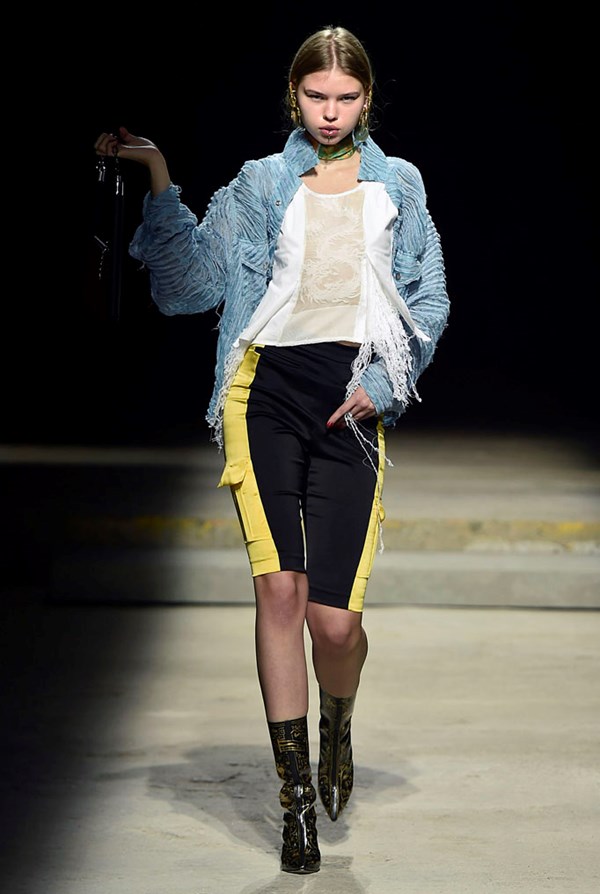Fashion East is a pioneering non-profit initiative established by Lulu Kennedy and the Old Truman Brewery in 2000. The scheme champions emerging designers, showcasing them on the catwalk at London Fashion Week.
Fashion East’s high profile panel of industry experts, who offer guidance and mentoring support, select the designers for London Fashion Week. As part of the scheme, designers receive a bursary, a fully produced runway show and are taken to Paris to hold sales appointments with international stores.
Fashion East has an unrivaled reputation for identifying and supporting the most exciting new names in the industry and has well started the careers of many British most prolific design talents including Gareth Pugh, Jonathan Saunders, House of Holland, Louise Gray, Ashley Williams, Marques Almeida and etc.
Fashion East designers for SS18: ASAI, Matty Bovan, and Supriya Lele.
SUPRIYA LELE
Supriya Lele is a British-born Master’s graduate of the Royal College of Art. The designer is looking at the clash of tradition and modernity in India, her family’s country of origin, as it’s developing into a tech-driven superpower.
SS18 is Lele’s second season on the Fashion East platform and her concise collection comprising of twelve looks cements her fascination with draping, synthetics and handiwork techniques informed by her Indian heritage. “ I love the idea of re-interpretation and recontextualization,” says thirty-year-old Lele who grew up in the West Midlands. A promisingly slick combination of sari-influenced asymmetric drape, madras-print T-shirts, tailoring, and technical fabrics sparked up by minimal deployments of Indian jewelry in the shape of slim crystal belts, armbands, and drop earrings. “I went back to India for the first time in eight years and was astonished to see this rampant boom going on; super fast internet, buildings going up everywhere,” she said. “But then, they are being constructed with bamboo scaffolding, and workers free-climbing up these concrete high-rises.”
In her work, the raw and the polished are made to clash. “ I think that’s what makes things modern, fresh,” she says. The collection also features a check print on mesh inspired by the sweat clothes that Indian men carry and a standout cyclamen pink draped off the shoulder dress that twists around the front and pins and the back exposing slithers of skin as would a sari. “Reduction, purity, confidence, and attitude – that’s what I want to achieve,” says Lele.
ASAI
A Sai Ta was born in southern London to Chinese refugees who fled Vietnam. The creator made a statement in his press note that his collection is dealing with “the concept, and perhaps the fear, of China’s strength.”
After being headhunted by Kanye West to work on Yeezy, a year into his MA schooling at Central Saint Martins and a stint at The Row, A Sai returned to London and launched the eponymous label ASAI.
The collection is a collision of day and eveningwear fabrics in vibrant hues, making the every day into couture, and vice versa. A Sai’s intensely technical ‘interlocking embroidery’ technique plays across tube tops and skirts that have been worked to the point of disintegration. Silk, the most iconic Chinese fabric is made into a grandiose opera coat and off the shoulder dress.
Bamboo, emblematic of both function and strength, appears as golden jewelry, a nod to the girls of A Sai’s South London childhood. Nunchuks, the iconic self-defense tool, become a handbag. Goldfish and dragons swirl across vertiginous heels, while diamante and tie-dye flowers adorn shoes.
Soft and tough, flashy and refined, silk and denim – it’s a wild mash-up. Just like the designer himself.
Supriya Lele and A Sai Ta are using personal, cultural filters to observe major issues of our times. Also, they brought in their friends of multiple shapes, ethnicities, and heights to walk for them.
The strength of its people, who’ve endured and thrived round the world. The culture they’ve taken with them, how it’s morphed and shifted but remained essentially unchanged, from London to Vietnam, where A Sai’s parents moved.
MATTY BOVAN
Matty Bovan’s third collection was based on the world’s events as well. The collection is one person’s response to the dystopian situation faced by people coming of age today.
The collection turned to practical details from sports performance wear, from skateboarding to motocross, have been decontextualized and given a new purely aesthetic purpose. Individually crafted acrylic sjin pads find a new function in decorating arms. The crass branding of motor racing has inspired a series of aggressively graphic prints, with shouty, brightly colored logos fighting for space on the body.
And of course, the most functional design details of all, the pocket, appears everywhere as a matter of adornment rather than practicality.
The knitwear is tough and shredded and the fabrications brutal. Raw-edged woven and knitted panels in various colors and textures are attached to one another with big blanket stitches or even plastic clips.
“A matter of balancing the desirable with the frankly revolting. I will take elements that initially I think are gross and manipulate them into something I like, in a way that might make people change their opinion about what’s gross and what isn’t” designer said. Probably it wouldn’t change costumer opinion that much about the gross things, but Matty Bovan definitely made his mind statement.

















No Comment